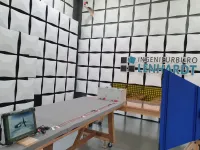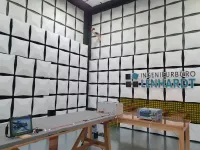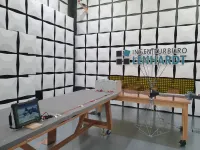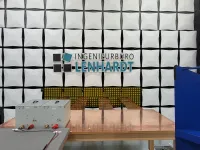MIL-STD-461
EMC Military Test Standard
MIL-STD-461G is a set of standards issued by the U.S. Department of Defense (U.S. DoD) that focuses on electromagnetic compatibility (EMC) requirements for military equipment and systems.Electromagnetic Compatibility Testing
EMC Testing for the Military Defense Industry
As a trusted partner specializing in electromagnetic compatibility (EMC) testing, IB-Lenhardt AG and its subsidiary IBL-Lab GmbH proudly offer a comprehensive range of EMC testing services aligned with military standards. Our primary objective is to assist in the early-stage development of military communication systems and components, ensuring their compliance with stringent requirements.
Our expert team conducts interference emission and immunity analyses to assess the potential propagation and reception of electromagnetic energy, as well as radio frequency interference. By subjecting components to rigorous EMC testing, we guarantee their electromagnetic compatibility with surrounding devices while minimizing vulnerability to external sources.
With our extensive experience and profound expertise in EMC testing, we are fully equipped to handle your project with utmost professionalism. You can count on us to support you from the start, giving you peace of mind that you are working with an experienced industry leader.
MIL-STD-461G
Measurement Classification
In 1967, the U.S. Department of Defense introduced MIL-STD-461 to incorporate electromagnetic compatibility considerations into the development of military communications technology. Since then, several revisions of MIL-STD-461 have been published. The most recent revision, known as MIL-STD-461G, was published in 2015. Although compliance with MIL-STD-461 is not mandatory for non-military entities, many civilian organizations are also adopting the standard.
The MIL-STD-461G EMC standard describes in detail the tests that must be performed on any type of electronic, electrical or electromechanical equipment used in military applications.
The tests are divided into:
Emission measurements
Susceptibility measurements
Conducted measurements
Radiated measurements
- Conducted Emission: CE1xx
- Radiated Emission: RE1xx
- Conducted Susceptibility: CS1xx
- Radiated Susceptibility: RS1xx
Let's get in Touch
The experts at IB-Lenhardt AG and IBL-Lab GmbH are always there for you. Just contact us!Video Introduction
Military Standard Testing
The Department of Defense and the US military requires that all of its equipment be tested to the highest standards. Many commercial OEMs have followed suit and adopted MIL-STD 810 and MIL-STD 461 as the benchmark for environmental and EMC testing.
Watch this informative video from Alltest Instruments to learn more about the basics.
Main Changes
MIL-STD-461G Test Updates
Now supports FFT time domain for EMI
Threshold of immunity introduces additional frequency zoom
Passive devices like antennas, LISN, and current probes require calibration only initially or after repair. Measurement system integrity check introduced for all test cases
Cable routing on test table for floor standing equipment
Test CS106 deleted (Conducted susceptibility, transients on power line) (was newly introduced in MIL STD 461F)
New test case CS117: Conducted Susceptibility, Lightning Induced Transients, Cables and Power Leads
New test case CS118: Conducted Susceptibility, Personnel Borne Electrostatic Discharge
CE102: LISN performance verification at 10.5 kHz and 100 kHz
CE106 / RE103: New rules for upper test frequency
CS101: Use of test receiver as alternative for oscilloscope
CS114: Calibration setup of BCI clamp / monitoring clamp combination
CS114: Change of forward power level limitation
RE102: Upper test frequency always 18 GHz
RS103: Field measurement only by field probe
CS114 / RS103: Verification of modulation with 40 dB dynamic
All equipment and ancillary gear including antennas not being actively used for a particular subset of radiated tests shall be removed from the test area
Applicability
The MIL-STD-461G Standard is applicable for subsystems and equipment of:
Applicability
The MIL-STD-461G Standard is applicable for subsystems and equipment of:
Test Procedures
Equipment and Subsystems
Subtests
Emission and Susceptibility
Conducted and radiated Emission
| CE101 | Power Leads, 30 Hz to 10 kHz |
|---|---|
| CE102 | Power Leads, 10 kHz to 10 MHz |
| CE106 | Antenna Terminal, 10 kHz to 40 GHz |
| RE101 | Magnetic Field, 30 Hz to 100 kHz |
| RE102 | Electric Field, 10 kHz to 18 GHz |
| RE103 | Antenna spurious and harmonic outputs, 10 kHz to 40 GHz |
Conducted and radiated Susceptibility
| CS101 | Power Leads, 30 Hz to 150 kHz |
|---|---|
| CS103 | Antenna Port, Intermodulation, 15 kHz to 10 GHz |
| CS104 | Antenna Port, Rejection of Undesired Signals, 30 Hz to 20 GHz |
| CS105 | Antenna Port, Cross-Modulation, 30 Hz to 20 GHz |
| CS109 | Structure Current, 60 Hz to 100 kHz |
| CS114 | Bulk Cable Injection (BCI), 10 kHz to 200 MHz |
| CS115 | Bulk Cable Injection (BCI), Impulse Excitation |
| CS116 | Damped Sinusoidal Transients, Cables and Power Leads |
| CS117 | Lightning Induced Transients |
| CS118 | Personnel Borne Electrostatic Discharge |
| RS101 | Magnetic Field, 30 Hz to 100 kHz |
| RS103 | Electric Field, 2 MHz to 40 GHz |
| RS105 | Transient Electromagnetic Field |
| Subtest | Scope | Subtest | Scope |
|---|---|---|---|
| Conducted and radiated Emission | |||
| CE101 | Power Leads, 30 Hz to 10 kHz | RE101 | Magnetic Field, 30 Hz to 100 kHz |
| CE102 | Power Leads, 10 kHz to 10 MHz | RE102 | Electric Field, 10 kHz to 18 GHz |
| CE106 | Antenna Terminal, 10 kHz to 40 GHz | RE103 | Antenna spurious and harmonic outputs, 10 kHz to 40 GHz |
| Conducted and radiated Susceptibility | |||
| CS101 | Power Leads, 30 Hz to 150 kHz | CS116 | Damped Sinusoidal Transients, Cables and Power Leads |
| CS103 | Antenna Port, Intermodulation, 15 kHz to 10 GHz | CS117 | Lightning Induced Transients |
| CS104 | Antenna Port, Rejection of Undesired Signals, 30 Hz to 20 GHz | CS118 | Personnel Borne Electrostatic Discharge |
| CS105 | Antenna Port, Cross-Modulation, 30 Hz to 20 GHz | RS101 | Magnetic Field, 30 Hz to 100 kHz |
| CS109 | Structure Current, 60 Hz to 100 kHz | RS103 | Electric Field, 2 MHz to 40 GHz |
| CS114 | Bulk Cable Injection (BCI), 10 kHz to 200 MHz | RS105 | Transient Electromagnetic Field |
| CS115 | Bulk Cable Injection (BCI), Impulse Excitation |
Contact us
MIL-STD-461 Testing
Have questions about the testing scope? We're delighted to provide answers and guidance. Contact us today through our convenient contact form or give us a call to discuss the details of your request.
GENERAL REQUIREMENTS
Measurement Set-up
- Calibration
-
Calibrate devices acc. to ANSI/ISO/IEC 17025 or ISO 10012 Passive devices (i.e. antennas, clamps, probes) require only initial calibration.
- Test environment
-
Measurements preferably done in anechoic rooms
- Tolerances
-
Distance: ±5%
Frequency: ±2%
Amplitude, measurement receiver: ±2 dB
Amplitude, measurement system (includes measurement receivers, transducers, cables, and so forth): ±3 dB
Time (waveforms): ±5%
Resistors: ±5%
Capacitors: ±20%
- Environmental noise
-
> 6 dB below the required limit for CE101 / CE102 the Equipment Under Test has to be replaced by a resistive load.
- Ground plane
-
The EUT shall be installed on a ground plane that simulates the actual installation. If the actual installation is unknown or multiple installations are expected, then a metallic ground plane shall be used.
- Metallic ground plane
-
Size: > 2.25 m²
Depth: > 76 cm
Resistance: < 0.1 mOhm/square
Bonding Distance between ground connectors: < 1 m
Format: < 5:1
Material: Solid
Ground resistance: < 2.5 mOhm
Instrumentation Set-up
Instrumentation Set-up
Related Test Methods
European and International Military Standards
DEF-STAN 59-41
DEF-STAN 59-411
MIL-STD-462
MIL-STD-464
MIL-STD-704
MIL-STD-810
MIL-STD-1275
NATO: AECTP 250
NATO: AECTP 500
RTCA: RTCA/DO-160
Accreditation Services
For Worldwide Market Access
With our accredited certification services, your market access can be fast and efficient. Learn more about certification bodies.
CE (Europe)
Certification for the European market
FCC (USA)
Certification for the United States
ISED (Canada)
Certification for the Canadian market
MIC (Japan)
Certification for the Japanese market
Full Scope Services of Military Communication and Short Range Radar Systems
Comprehensive EMC and RF testing methods to military standards (MIL-STD, Def Stan)
End-to-end DAkkS-accredited testing capabilities: anechoic and semi-anechoic chambers, copper shielded rooms and ground planes
Expert test engineers with many years of experience
Single-source test solutions for defense standards validation
Comprehensive consulting services: support for military equipment qualification, meeting contract deadlines, component verification assistance
Our engineers not only deliver the testing but also stand at your side for consulting on any questions or difficulties you may have.




